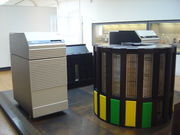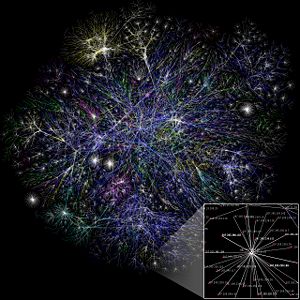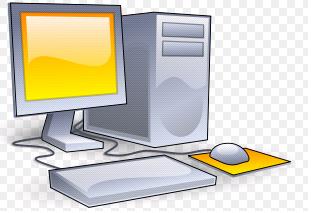COMPUTER
A computer is a machine that manipulates data according to a list of instructions.
WORKING A general purpose computer has four main sections: the arithmetic and logic unit (ALU), the control unit, the memory, and the input and output devices (collectively termed I/O). These parts are interconnected by busses, often made of groups of wires.
The control unit, ALU, registers, and basic I/O (and often other hardware closely linked with these) are collectively known as a central processing unit (CPU). Early CPUs were composed of many separate components but since the mid-1970s CPUs have typically been constructed on a single integrated circuit called a microprocessor
.1. CONTROL UNIT.The control unit (often called a control system or central controller) directs the various components of a computer. It reads and interprets (decodes) instructions in the program one by one. The control system decodes each instruction and turns it into a series of control signals that operate the other parts of the computer.
2. Arithmetic/logic unit (ALU)The ALU is capable of performing two classes of operations: arithmetic and logic.The set of arithmetic operations that a particular ALU supports may be limited to adding and subtracting or might include multiplying or dividing, trigonometry functions (sine, cosine, etc) and square roots. Some can only operate on whole numbers (integers) whilst others use floating point to represent real numbers—albeit with limited precision.Superscalar computers contain multiple ALUs so that they can process several instructions at the same time.
3.MEMORY  A computer’s memory can be viewed as a list of cells into which numbers can be placed or read. Each cell has a numbered “address” and can store a single number In almost all modern computers, each memory cell is set up to store binary numbers in groups of eight bits (called a byte).
A computer’s memory can be viewed as a list of cells into which numbers can be placed or read. Each cell has a numbered “address” and can store a single number In almost all modern computers, each memory cell is set up to store binary numbers in groups of eight bits (called a byte).
The CPU contains a special set of memory cells called registers that can be read and written to much more rapidly than the main memory area. There are typically between two and one hundred registers depending on the type of CPU. Registers are used for the most frequently needed data items to avoid having to access main memory every time data is needed. Computer main memory comes in two principal varieties: random access memory or RAM and read-only memory or ROM. RAM can be read and written to anytime the CPU commands it, but ROM is pre-loaded with data and software that never changes, so the CPU can only read from it. ROM is typically used to store the computer’s initial start-up instructions. In general, the contents of RAM is erased when the power to the computer is turned off while ROM retains its data indefinitely.
4.MULTIPROCESSING
 Some computers may divide their work between one or more separate CPUs, creating a multiprocessing configuration. Traditionally, this technique was utilized only in large and powerful computers such as supercomputers, mainframe computers and servers. However, multiprocessor and multi-core (multiple CPUs on a single integrated circuit) personal and laptop computers have become widely available and are beginning to see increased usage in lower-end markets as a result.
Some computers may divide their work between one or more separate CPUs, creating a multiprocessing configuration. Traditionally, this technique was utilized only in large and powerful computers such as supercomputers, mainframe computers and servers. However, multiprocessor and multi-core (multiple CPUs on a single integrated circuit) personal and laptop computers have become widely available and are beginning to see increased usage in lower-end markets as a result.
5. Networking and the Internet In the 1970s, computer engineers at research institutions throughout the United States began to link their computers together using telecommunications technology. This effort was funded by ARPA (now DARPA), and the computer network that it produced was called the ARPANET.
In the 1970s, computer engineers at research institutions throughout the United States began to link their computers together using telecommunications technology. This effort was funded by ARPA (now DARPA), and the computer network that it produced was called the ARPANET.



